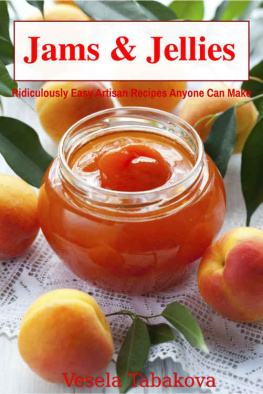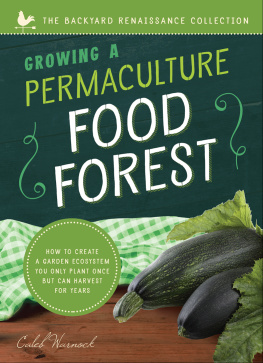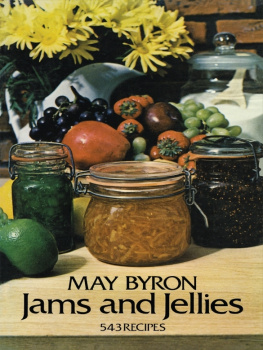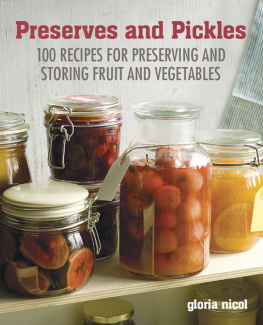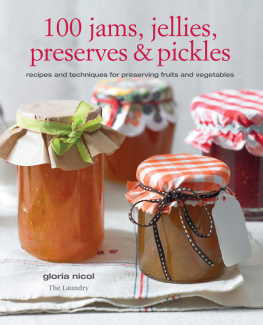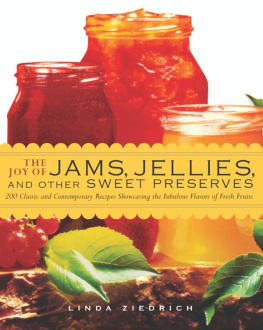Tabakova - Jams & Jellies: Ridiculously Easy Artisan Recipes Anyone Can Make
Here you can read online Tabakova - Jams & Jellies: Ridiculously Easy Artisan Recipes Anyone Can Make full text of the book (entire story) in english for free. Download pdf and epub, get meaning, cover and reviews about this ebook. year: 2014, genre: Home and family. Description of the work, (preface) as well as reviews are available. Best literature library LitArk.com created for fans of good reading and offers a wide selection of genres:
Romance novel
Science fiction
Adventure
Detective
Science
History
Home and family
Prose
Art
Politics
Computer
Non-fiction
Religion
Business
Children
Humor
Choose a favorite category and find really read worthwhile books. Enjoy immersion in the world of imagination, feel the emotions of the characters or learn something new for yourself, make an fascinating discovery.
- Book:Jams & Jellies: Ridiculously Easy Artisan Recipes Anyone Can Make
- Author:
- Genre:
- Year:2014
- Rating:3 / 5
- Favourites:Add to favourites
- Your mark:
- 60
- 1
- 2
- 3
- 4
- 5
Jams & Jellies: Ridiculously Easy Artisan Recipes Anyone Can Make: summary, description and annotation
We offer to read an annotation, description, summary or preface (depends on what the author of the book "Jams & Jellies: Ridiculously Easy Artisan Recipes Anyone Can Make" wrote himself). If you haven't found the necessary information about the book — write in the comments, we will try to find it.
Tabakova: author's other books
Who wrote Jams & Jellies: Ridiculously Easy Artisan Recipes Anyone Can Make? Find out the surname, the name of the author of the book and a list of all author's works by series.
Jams & Jellies: Ridiculously Easy Artisan Recipes Anyone Can Make — read online for free the complete book (whole text) full work
Below is the text of the book, divided by pages. System saving the place of the last page read, allows you to conveniently read the book "Jams & Jellies: Ridiculously Easy Artisan Recipes Anyone Can Make" online for free, without having to search again every time where you left off. Put a bookmark, and you can go to the page where you finished reading at any time.
Font size:
Interval:
Bookmark:
by Vesela Tabakova
Text copyright(c)2014 Vesela Tabakova
All rights reserved. No part of this publication may be reproduced, distributed, or transmitted in any form or by any means, including photocopying, recording, or other electronic or mechanical methods, without the prior written permission of the publisher, except in the case of brief quotations embodied in critical reviews and certain other noncommercial uses permitted by copyright law.
Although every precaution has been taken to verify the accuracy of the information contained herein, the author and publisher assume no responsibility for any errors or omissions. No liability is assumed for damages that may result from the use of information contained within.
I Love You Mom!

When I think about my childhood I realize that growing up in a former Communist country was really interesting and very different from the way we live now.We usually had plenty of colorful fruit and vegetables in the summer but when winter came there was nothing particularly enticing in the food shops apartfrom basic food staples like meat, dairy and bread. No fresh fruit, no vegetables, no commercial sauces or ready-made meals - nothing for at least six orseven winter months until the next crops had grown and ripened. So everybody, and I mean literally every family, had one and the same ritual every summer buying from the farmers` market or picking from our gardens fresh cherries, berries, peaches, plums, pears and seasonal vegetables like tomatoes, peppers,eggplants, green beans or peas and preparing different kinds of delicious preserves. All these summer fruits and vegetables, picked at their peak, whenplentiful and prices are low, provided much needed variety when winter came. All the family members were involved in some way or another and it was funbut, more importantly, it was essential because it was the only way to ensure that we could eat a varied and healthy diet during the winter.
Now life has changed a lot and we no longer have to stock food for the colder months. There are plenty of fruit and vegetables available in the shops allyear round and, of course, we now have freezers, too. But the tradition of canning and preserving the summer flavors in jars and filling the pantry withcolorful jams, jellies and pickles to enjoy throughout the year has deep roots in our culture and we still do it. Moreover, summer vegetables andfruit have the highest nutritional content so preserving them for the cold months makes sense and is really not hard at all. Anyone can do it and itdoesnt require much effort. Not only will you have preserved the best of the summer fruits for your own enjoyment, but you can give quite impressive giftsto friends that will be appreciated and long remembered.
Each summer my family prepares more than 200 jars of fruit preserves and pickled vegetables so we can use them all year long. As well as a great way topreserve the fresh, summer flavors this has the added benefit of giving us control over the quality of our food by avoiding any undesirable additives andpreservatives found in many commercial products.
In my new series of recipe books I share my best homemade jams and jellies recipes and tips. If you are a veteran jam maker, you may find these recipesridiculously easy. If, however, you are a novice, I believe you will actually enjoy making them and your family will certainly enjoy the taste of summer inthe months ahead.

To prepare the healthiest and easiest jams in the world use just ripe, preferably organic, fruit and either organic sugar or organic honey. Usingfrozen or overripe fruit is not a good idea because they have lost their natural pectin. I don't add pectin to my jams and don't use sugarsubstitutes. The whole idea of jam-making is to preserve fruit with sugar so a sugarfree jam does not taste good and is not healthy at all becausein order to make it you have to add some processed ingredients.
The best jams can be easily made with just basic kitchen utensils - large, shallow pans, ladles and, of course, some jars with lids and rubberrings that create a vacuum seal. There is no need to use special canners or other equipment designed just for that purpose.
Before filling the jars with the prepared jam you have to keep them hot either by simmering them together with the lids for at least 10 minutes orby keeping them in a C 200-degree oven.
Cook fruit very slowly at first over low heat to extract the maximum amount of juice and pectin. Stir frequently until tender, but do not overcook.
In Europe jam and jelly recipes usually call for equal amounts of sugar and fruit, by weight. Sugar acts as a preservative, so there is no need to addpectin. We just fill the jars with the hot jam and then turn them upside down. Once theyve cooled, they are sealed and should last quite a few months. Butif you prefer to follow the traditional way of sealing jam-filled jars, just place them into a large pot with a rack. Fill with water to cover the jars byat least 2 inches. Cover with a lid and bring to the boil. Boil for 10 minutes, remove the jars and set aside to cool. Bon Appetit!

One thing you always have to do before you start following the recipes is to wash your jars and lids in warm, soapy water or in the dishwasher. Then youplace them in a large pot, with water to 2 inches above the jars, and boil them for 10 minutes. After that just leave the jars in hot water or in a warmoven until needed.
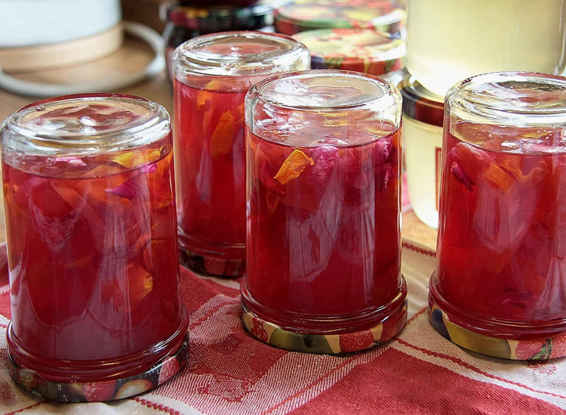
Makes 6-7 11 oz jars
Ingredients:
4 lb fresh strawberries (stemmed and cleaned)
5 cups sugar
2 tbsp lemon juice or 1 tsp citric acid
Directions:
Combine strawberries and sugar in a large, shallow saucepan and allow to stand for 3 to 4 hours or leave in the fridge overnight. Bring mixture slowly tothe boil, stirring until sugar is dissolved. Boil for 40 minutes, skimming any foam off the top once or twice. Drop a small amount of the jam on a plateand wait a minute to see if it has thickened. If it has gelled enough, turn off the heat. If not, keep boiling and test every 5 minutes until ready. Two orthree minutes before you remove the jam from the heat, add lemon juice or citric acid and stir well.
Ladle the hot jam into the jars up to 1/8-inch from the top. Place the lid on top securely and flip the jar upside down. Continue until all of the jars arefilled and upside down. Allow the jam to cool completely before turning right-side up. Press on the lid to check and see if it has sealed. If one of thejars lids doesnt pop up, the jar is not sealed, so you should store it in the fridge.
My grandmother has been making jam for nearly 60 years and has never used a water bath. Her technique of turning the jars upside down creates a perfectseal and she has never had a failure. But if you decide to process the jams in the traditional way, place them into a large pot with a rack, cover the jarswith water by at least 2 inches and bring to the boil. Boil for 10 minutes, remove the jars and allow to cool.
Font size:
Interval:
Bookmark:
Similar books «Jams & Jellies: Ridiculously Easy Artisan Recipes Anyone Can Make»
Look at similar books to Jams & Jellies: Ridiculously Easy Artisan Recipes Anyone Can Make. We have selected literature similar in name and meaning in the hope of providing readers with more options to find new, interesting, not yet read works.
Discussion, reviews of the book Jams & Jellies: Ridiculously Easy Artisan Recipes Anyone Can Make and just readers' own opinions. Leave your comments, write what you think about the work, its meaning or the main characters. Specify what exactly you liked and what you didn't like, and why you think so.

